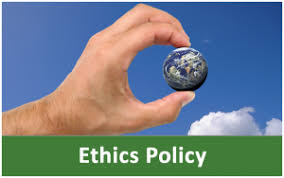Nine Attributes of a Good Ethics Policy
The first objective of any ethics policy is to facilitate legitimate ethical reasoning activity. It is impossible to merely glance at an ethics policy and judge its “goodness.” The true test of any ethics policy is how it actually works within a specific organization. The following attributes are frequently missing in weak ethics policies, and are positive drivers in strong policies:
1. Addressing the “Big E“ (not just the “little e”)
Policies not only need to address compliance issues (the “little e”) but the “Big E” issues such as reasoning, prevention and performance. The “little e” is more about control and compliance, whereas the “Big E” is about assuring that intents, means, and ends are “good.” For ethics policies to be impactful and truly improve ethics and contribute value to the organization, they need to be more about the “Big E” than the “little e.”
2. Universality
Ethical policies must be based on sound logic and universal ethical principles (such as The Golden Rule and The Greatest Good), and these universal principles must be capable of trumping compliance policies.
3. Sound Logical Reasoning
Most ethical reasoning flaws begin with logical reasoning flaws. Ethics policies need to reflect a commitment to data driven and logical decision processes, information sharing, effective dialog and examination. Ethics can not operate without facts and execution between people. See our training aid Organizational Reasoning.
4. Ethical Examination Skills
Ethical reasoning is a process capability that is a component of organizational reasoning capability. Without sound ethical reasoning the organization becomes less capable of solving problems and making sound decisions. Ethics policies need to reflect a commitment to developing ethical reasoning capabilities at every level of the organization, with every employee, regarding how to elevate dialog and reasoning to “right versus right” reasoning modes. Developing and sustaining such skills requires an organizational commitment to training, practice and rewards. See our training services.
5. Transforming “wrong” to “right” and “bad” to “good”
Good ethics policies promote skills where logical fallacies and ethical lower forms will be identified and transformed into higher forms of universal ethical reasoning. The transformation of wrong thinking, wrong actions, and bad outcomes to right thinking, right actions and good outcomes is the “blocking and tackling” of organizational ethics. See our training aid 101 Fallacies and Lower Forms. To encourage this constructive activity the policy must assure that any employee may freely engage and question the ethics of any action without penalty. The organization needs to actively solicit inputs from all participants to aid in the identification of ethical issues. See our Online Group Surveys and Diagnostics.
6. Prevention
Ethical policies need to emphasize the importance of identifying “bad” ethical rationale and transforming them to “good” ethical rationale, as stated in Attribute #5, but with one kicker: It must be accomplished “before the fact.” Most ethics policies are compliance based and merely catch wrongdoing “after the fact” when many of the failures, if they had been identified earlier, could have easily been prevented. A good ethics policy incorporates early warnings and checks and balances, not merely to catch and punish violators, but to identify emerging risks, facilitate behavior change, and to prevent ethics failures.
7. Organizational Change Orientation
Organizational processes and practices impose a dominating influence on individual ethical behavior in organizations. Ethics policies need to encourage and reward the willingness to adapt values and behavior patterns to improve the organization’s moral maturity. Policies need to confront processes more than individual’s actions, and focus more on awareness and change than just compliance. Adherence to fixed value positions at the exclusion of systematic causes in an organizational context can itself become a cause of unethical behavior, posing an even greater liability to the group than minor issues of noncompliance. Moving the entire group to the next moral maturity level is far more important to organizational well-being than punishing an employee for a petty violation that should have been prevented in the first place.
8. Employee Training
Ethics policies should require uniform ethics training around logically applied universal ethical principles. Furthermore, after initial training the principles need to be continuously emphasized, integrated and promoted by a structured managerial effort, team or committee. Most employees need to be exposed to the ethical principles several times before they can internalize them, and most need to actively practice them with the support of fellow workers to develop proficiency with them. See courses: Basic Ethics Training and Getting Ethics into Organizations.
9. Leadership by Example
Ethics policies are not tactical or symbolic monuments that executives can erect and delegate, or worse yet ignore. Ethics policies are only as valid as the commitment management give to them. Management is ultimately responsible for the firm’s moral maturity level, and therefore needs to be held to a higher ethical standard than regular employees, not the lower standard we too often see among corporate leaders. Management’s commitment to organizational ethics sets the tone for the ethical direction and performance of the entire organization. Management determines whether that direction is positive, negative, or stagnant. Therefore, ethics policies themselves are not the primary indicator of an organization’s moral maturity. Management’s commitment to preventing poor organizational reasoning and conduct, and their willingness to hold themselves to a higher standard and lead by example, are the two greatest indicators of ethics excellence in the organization.

